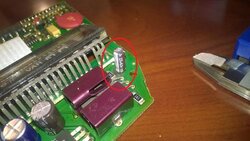arco777
Explorer Addict
- Joined
- April 6, 2008
- Messages
- 2,404
- Reaction score
- 59
- Year, Model & Trim Level
- 1994 Explorer 2dr 4x4
Got a blank overhead console temperature/compass display? Here's how to fix one variant of the circuitry that is at fault. There are two different circuit boards commonly installed in the overhead console. Both tend to fail after so many years. The somewhat more common circuit board has a "510" resistor that burns out, and replacement of the resistor is documented in a different thread on this forum. Also check the FSB Forums (fullsize Bronco) as there is information on 510 resistor replacement there too. This thread shows repair of the other less common circuit board, which has a capacitor that leaks and causes the display to boot up after a long delay or not at all. If you get halfway through this guide and your circuit board does not match the pictures, search the forums for info on replacement of the 510 resistor.
Note that the console pictured is from a fullsize Bronco; the electronics are the same and the design is very similar. The circuit board pictured is actually from an Explorer.
Start by removing the overhead console from the vehicle. In an Explorer there are two screws that you will need to remove before it will drop down. See picture for screw locations circled in red.
Note that the console pictured is from a fullsize Bronco; the electronics are the same and the design is very similar. The circuit board pictured is actually from an Explorer.
Start by removing the overhead console from the vehicle. In an Explorer there are two screws that you will need to remove before it will drop down. See picture for screw locations circled in red.




























